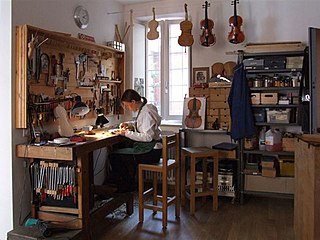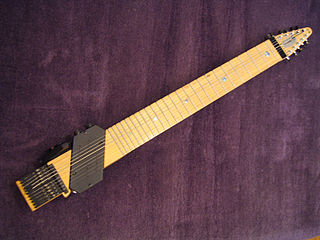
The steel-string acoustic guitar is a modern form of guitar that descends from the gut-strung Romantic guitar, but is strung with steel strings for a brighter, louder sound. Like the modern classical guitar, it is often referred to simply as an acoustic guitar, or sometimes as a folk guitar.

The bass guitar, electric bass or simply bass is the lowest-pitched member of the guitar family. It is a plucked string instrument similar in appearance and construction to an electric or acoustic guitar, but with a longer neck and scale length. The bass guitar most commonly has four strings, though five- and six-stringed models are also relatively popular, and bass guitars with even more strings or courses have been built. Since the mid-1950s, the bass guitar has largely come to replace the double bass in popular music due to its lighter weight, the inclusion of frets in most models, and, most importantly, its design for electric amplification. This is also because the double bass is acoustically compromised for its range in that it is scaled down from the optimal size that would be appropriate for those low notes.

The guitar is a stringed musical instrument that is usually fretted and typically has six or twelve strings. It is usually held flat against the player's body and played by strumming or plucking the strings with the dominant hand, while simultaneously pressing selected strings against frets with the fingers of the opposite hand. A guitar pick may also be used to strike the strings. The sound of the guitar is projected either acoustically, by means of a resonant hollow chamber on the guitar, or amplified by an electronic pickup and an amplifier.

Jazz guitar may refer to either a type of electric guitar or a guitar playing style in jazz, using electric amplification to increase the volume of acoustic guitars.
The fingerboard is an important component of most stringed instruments. It is a thin, long strip of material, usually wood, that is laminated to the front of the neck of an instrument. The strings run over the fingerboard, between the nut and bridge. To play the instrument, a musician presses strings down to the fingerboard to change the vibrating length, changing the pitch. This is called stopping the strings. Depending on the instrument and the style of music, the musician may pluck, strum or bow one or more strings with the hand that is not fretting the notes. On some instruments, notes can be sounded by the fretting hand alone, such as with hammer ons, an electric guitar technique.

A luthier is a craftsperson who builds or repairs string instruments.

A prepared guitar is a guitar that has had its timbre altered by placing various objects on or between the instrument's strings, including other extended techniques. This practice is sometimes called tabletop guitar, because many prepared guitarists do not hold the instrument in the usual manner, but instead place the guitar on a table to manipulate it.

The bajo sexto is a Mexican string instrument from the guitar family with 12 strings in six double courses.

Guitar tunings are the assignment of pitches to the open strings of guitars, including classical guitars, acoustic guitars, and electric guitars. Tunings are described by the particular pitches that are made by notes in Western music. By convention, the notes are ordered and arranged from the lowest-pitched string to the highest-pitched string, or the thickest string to thinnest, or the lowest frequency to the highest. This sometimes confuses beginner guitarists, since the highest-pitched string is referred to as the 1st string, and the lowest-pitched is the 6th string.

Parker Guitars was an American manufacturer of electric and acoustic guitars and basses, founded by luthier Ken Parker in 1993. Parker guitars were distinguished for their characteristic light weight and the use of composite materials.

Acoustic music is music that solely or primarily uses instruments that produce sound through acoustic means, as opposed to electric or electronic means. While all music was once acoustic, the retronym "acoustic music" appeared after the advent of electric instruments, such as the electric guitar, electric violin, electric organ and synthesizer. Acoustic string instrumentations had long been a subset of popular music, particularly in folk. It stood in contrast to various other types of music in various eras, including big band music in the pre-rock era, and electric music in the rock era.

A multi-neck guitar is a guitar that has multiple fingerboard necks. They exist in both electric and acoustic versions. Examples of multi-neck guitars and lutes go back at least to the Renaissance.

An experimental musical instrument is a musical instrument that modifies or extends an existing instrument or class of instruments, or defines or creates a new class of instrument. Some are created through simple modifications, such as cracked cymbals or metal objects inserted between piano strings in a prepared piano. Some experimental instruments are created from household items like a homemade mute for brass instruments such as bathtub plugs. Other experimental instruments are created from electronic spare parts, or by mixing acoustic instruments with electric components.

Trigger is a modified Martin N-20 nylon-string classical acoustic guitar used by country music singer-songwriter Willie Nelson. Early in his career, Nelson tested several guitars by different companies. After his Baldwin guitar was damaged in 1969, he purchased the Martin guitar, but retained the electrical components from the Baldwin guitar.

Suhr Guitars is an American company that manufactures electric guitars and basses, guitar amplifiers, and effect units. The company is based in Lake Elsinore, California and was founded in 1997 by John Suhr, who "has a reputation for building exquisitely crafted guitars" and Steve Smith.

Experimental luthiers are luthiers who take part in alternative stringed instrument manufacturing or create original string instruments altogether.
Petros Guitars are an elite customized acoustic guitar luthier, consisting of Bruce Petros and his son Matt Petros. They are based in Kaukauna, Wisconsin. They are noted for their exceptionally high quality craftsmanship and often make guitars similar in appearance to Spanish Baroque guitars with the design, making both steel and nylon string hand-made guitars. Bruce began making guitars in 1972, and in 2000 he was joined by his son to form the Petros company.
Andy Manson is a luthier who has been hand-crafting guitars for over four decades. He has also made mandolins and multi-necked instruments. He is based in England, and is known for his flat-top, acoustic-guitars. He has influenced pieces by Hugh's & Brook Guitars, Elysian Acoustics and Gary Nava.
William Allen Asher is a Californian-born luthier in the Los Angeles area. He has been in the guitar repair and restoration business for over 30 years and has been building high-end, custom guitars for 15 years. He is best known for helping revive the lap steel guitar instrument into popular music by creating a modern-day lap steel guitar that is now used in a variety of musical genres.
Jim Redgate is an Australian classical guitar luthier, who owns Redgate Guitars. As of 2012, he makes four models, the lattice-braced, the double-top, and the new wave double-top and traditional fan-braced. His customers include Pepe Romero, Ana Vidović, Ralph Towner, Slava Grigoryan, Leonard Grigoryan, Bertrand Thomas, Jeff Young, Gareth Koch, Odair Assad, Wolfgang Muthspiel, Karin Schaupp, Emmanuel Rossfelder, Hucky Eichelman, and Phillipe Mariotti. One author said of him, "Like fellow Australian Greg Smallman, Redgate builds his (lattice-braced) guitars with an arched back to improve their volume and projection, and he uses lightweight carbon fiber reinforcements under the soundboard. While not as thin as a Smallman's, Redgate's soundboards are much lighter than traditionally braced examples, and his guitars are therefore more responsive, energy efficient, and louder than traditional classical instruments."















